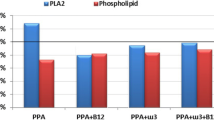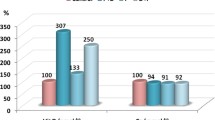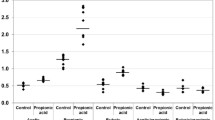Abstract
Metabolites of proper fatty acids modulate the inflammatory response and are essential for normal brain development; equally, abnormal fatty acid metabolism plays a critical role in the pathology of autism. Currently, dietary supplements are often used to improve the core symptoms of Autism spectrum disorder (ASD). The present study analyzed the effects of orally supplemented omega-3 (ω-3) and vitamin B12 on ameliorating oxidative stress and impaired lipid metabolism in a propionic acid (PPA)-induced rodent model of autism, together with their effect on the gut microbial composition, where great fluctuations in the bacterial number and strains were observed; interestingly, polyunsaturated fatty acids such as omega-3 induced higher growth of the gram-positive bacterium Staphylococcus aureus and decreased the survival rates of Clostridia sp. as well as other enteric bacterial strains. Thirty-five young male western albino rats were divided into five equal groups. The first group served as the control; the second group was given an oral neurotoxic dose of PPA (250 mg/kg body weight/day) for 3 days. The third group received an oral dose of ω-3 (200 mg/kg body weight/day) for 30 days after the 3-day PPA treatment. Group four was given an oral dose of vitamin B12 (16.7 mg/kg/day) for 30 days after PPA treatment. Finally, group five was given a combination of both ω-3 and vitamin B12 at the same dose for the same duration after PPA treatment. Biochemical parameters related to oxidative stress and impaired fatty acid metabolism were investigated in the brain homogenates of each group. The effects of the dietary supplements on the gut microbiota were also observed. The PPA-treated autistic model expressed significantly higher levels of lipid peroxides and 5-lipoxygenase (5-LOX) and significantly less glutathione (GSH), glutathione S-transferase (GST), and cyclooxygenase 2 (COX2) than the control group. However, a remarkable amelioration of most of the impaired markers was observed with oral supplementation with ω-3 and vitamin B12, either alone or in combination. Our results concluded that impairment at various steps of the lipid metabolic pathways may contribute to the development of autism; however, supplementation with ω-3 and vitamin B12 can result in a positive therapeutic effect.


Similar content being viewed by others
References
Abdou HM, Hassan MA (2014) Protective role of omega-3 polyunsaturated fatty acid against lead acetate-induced toxicity in liver and kidney of female rats. Biomed Res Int 2014:435857
Abdulmajeed NA, Alnahdi HS, Ayas NO, Mohamed AM (2015) Amelioration of cardiotoxic impacts of diclofenac sodium by vitamin B complex. Eur Rev Med Pharmacol Sci 19(4):671–681
Al-Amin MM, Rahman MM, Khan FR, Zaman F, Mahmud Reza H (2015) Astaxanthin improves behavioral disorder and oxidative stress in prenatal valproic acid-induced mice model of autism. Behav Brain Res 286:112–121
Albert MJ, Mathan VI, Baker SJ (1980) Vitamin B12 synthesis by human small intestinal bacteria. Nature 283:781–782
Bakken JS, Borody T, Brandt LJ, Brill JV, Demarco DC, Franzos MA, Moore TA (2011) Treating Clostridium difficile infection with fecal microbiota transplantation. Clin Gastroenterol Hepatol 9(12):1044–1049
Beutler E (1963) Improved method for determination of blood glutathione. J Lab Clin Med 61(5):882–888
Bienenstock J, Kunze W, Forsythe P (2015) Microbiota and the gut-brain axis. Nutr Rev 73(1):28–31
Borody TJ, Warren EF, Leis SM, Surace R, Ashman O, Siarakas S (2004) Bacteriotherapy using fecal flora: toying with human motions. J Clin Gastroenterol 38(6):475–483
Boudrault C, Bazinet RP, Kang JX, Ma DW (2010) Cyclooxygenase-2 and n-6 PUFA are lower and DHA is higher in the cortex of fat-1 mice. Neurochem Int 56(4):585–589
Brandt LJ, Bernstein LH, Wagle A (1977) Production of vitamin B 12 analogues in patients with small-bowel bacterial overgrowth. Ann Intern Med 87:546–551
Chauhan A, Chauhan V (2006) Oxidative stress in autism. Pathophysiology 13(3):171–181
Chauhan A, Chauhan V, Brown WT, Cohen I (2004) Oxidative stress in autism: increased lipid peroxidation and reduced serum levels of ceruloplasmin and transferrin-the antioxidant proteins. Life Sci 75(21):2539–2549
Cleland LG, James MJ, Proudman SM, Neumann MA, Gibson RA (1994) Inhibition of human neutrophil leukotriene B 4 synthesis in essential fatty acid deficiency: role of leukotriene a hydrolase. Lipids 29(3):151–155
Daghestani MH, Selim ME, Abd-Elhakim YM, Said EN, El-Hameed NEA, Khalil SR, El-Tawil OS (2017) The role of apitoxin in alleviating propionic acid-induced neurobehavioral impairments in rat pups: the expression pattern of Reelin gene. Biomed Pharmacother 93:48–56
Das UN (2008) Folic acid and polyunsaturated fatty acids improve cognitive function and prevent depression, dementia, and Alzheimer’s disease—but how and why? Prostaglandins Leukot Essent Fat Acids 78(1):11–19
Das UN, Ramos EJ, Meguid MM (2003) Metabolic alterations during inflammation and its modulation by central actions of omega-3 fatty acids. Curr Opin Clin Nutr Metab Care. 6(4):413–9.
Degnan PH, Barry NA, Mok KC, Taga ME, Goodman AL (2014) Human gut microbes use multiple transporters to distinguish vitamin B12 analogs and compete in the gut. Cell Host Microbe 15:47–57
Ding HT, Taur Y, Walkup JT (2017) Gut microbiota and autism: key concepts and findings. J Autism Dev Disord 47(2):480–489
El-Ansary AK, Bacha AB, Kotb M (2012) Etiology of autistic features: the persisting neurotoxic effects of propionic acid. J Neuroinflammation 9(1):74
El-Ansary A, Al-Ghamdi M, Bhat RS, Al-Daihan S, Al-Ayadhi L (2016) Potency of pre–post treatment of coenzyme Q10 and melatonin supplement in ameliorating the impaired fatty acid profile in rodent model of autism. Food Nutr Res 60(1):28127
El-Ansary A, Bjørklund G, Chirumbolo S, Alnakhli OM (2017) Predictive value of selected biomarkers related to metabolism and oxidative stress in children with autism spectrum disorder. Metab Brain Dis 32(4):1209–1221
Erdogan H, Antar V, Kaya AH, Fırat L, Kubilay T (2017) Animal models of autism spectrum disorder. J Neurol Stroke 6(4):00209
Feng Z, Zou X, Jia H, Li X, Zhu Z, Liu X, Wang J (2012) Maternal docosahexaenoic acid feeding protects against impairment of learning and memory and oxidative stress in prenatally stressed rats: possible role of neuronal mitochondria metabolism. Antioxid Redox Signal 16(3):275–289
Finegold SM, Summanen PH, Downes J, Corbett K, Komoriya T (2017) Detection of Clostridium perfringens toxin genes in the gut microbiota of autistic children. Anaerobe 2017:45,133–45,137
Fluegge K (2017) Propionic acid metabolism, ASD, and vitamin B12: is there a role for environmental nitrous oxide? Int J Dev Neurosci 57:21–23
Habig WH, Pabst MJ, Jakoby WB (1974) Glutathione S-transferases the first enzymatic step in mercapturic acid formation. J Biol Chem 249(22):7130–7139
Herstad KMV, Gajardo K, Bakke AM, Moe L, Ludvigsen J, Rudi K, Rud I, Sekelja M, Skancke E (2017) A diet change from dry food to beef induces reversible changes on the faecal microbiota in healthy, adult client-owned dogs. BMC Vet Res 13(147):147
Hooper LV, Gordon JI (2001) Commensal host-bacterial relationships in the gut. Science 292(5519):1115–1118
Hunaiti A (2016) Correlation between serum B12 levels and lipid peroxidation in B12 deficiency patients. J Hum Nutr Food Sci4(5):1100
Jagota SK, Dani HM (1982) A new colorimetric technique for the estimation of vitamin C using Folin phenol reagent. Anal Biochem 127(1):178–182
James SJ, Cutler P, Melnyk S, Jernigan S, Janak L, Gaylor DW, Neubrander JA (2004) Metabolic biomarkers of increased oxidative stress and impaired methylation capacity in children with autism. Am J Clin Nutr 80(6):1611–1617
Jankowska M, Lichodziejewska-Niemierko M, Rutkowski B, Debska-Slizien A, Małgorzewicz S (2017) Water soluble vitamins and peritoneal dialysis e state of the art. Clin Nutr 36(6):1483–1489
Kałużna-Czaplińska J, Jóźwik-Pruska J (2016) Chromatographic and mass spectrometric techniques in studies on oxidative stress in autism. J Chromatogr B 1019:4–14
Khalil SR, Abd-Elhakim YM, Selim ME, Al-Ayadhi LY (2015) Apitoxin protects rat pups brain from propionic acid-induced oxidative stress: the expression pattern of Bcl-2 and Caspase-3 apoptotic genes. Neurotoxicology 49:121–131
Khemakhem AM, Frye RE, El-Ansary A, Al-Ayadhi L, Bacha AB (2017) Novel biomarkers of metabolic dysfunction is autism spectrum disorder: potential for biological diagnostic markers. Metab Brain Dis:1–15
Kikuchi M, Kashii S, Honda Y, Tamura Y, Kaneda K, Akaike A (1997) Protective effects of methylcobalamin, a vitamin B12 analog, against glutamate-induced neurotoxicity in retinal cell culture. Invest Ophthalmol Vis Sci 38(5):848–854
Kuhn H, Banthiya S, van Leyen K (2015) Mammalian lipoxygenases and their biological relevance. Biochim Biophys Acta 1851(4):308–330
Ley RE, Hamady M, Lozupone C, Turnbaugh PJ, Ramey RR, Bircher JS, Gordon JI (2008) Evolution of mammals and their gut microbes. Science 320(5883):1647–1651
Liu Y, Chen F, Odle J, Lin X, Jacobi SK, Zhu H, Hou Y (2012) Fish oil enhances intestinal integrity and inhibits TLR4 and NOD2 signaling pathways in weaned pigs after LPS challenge. J Nutr 142(11):2017–2024
Luo Y, Kuang S, Xue L, Yang J (2016) The mechanism of 5-lipoxygenase in the impairment of learning and memory in rats subjected to chronic unpredictable mild stress. Physiol Behav 167:145–153
MacFabe DF, Cain DP, Rodriguez-Capote K, Franklin AE, Hoffman JE, Boon F, Ossenkopp KP (2007) Neurobiological effects of intraventricular propionic acid in rats: possible role of short chain fatty acids on the pathogenesis and characteristics of autism spectrum disorders. Behav Brain Res 176(1):149–169
Masuda Y, Kokubu T, Yamashita M, Ikeda H, Inoue S (1998) Egg phosphatidylcholine combined with vitamin B 12 improved memory impairment following lesioning of nucleus basalis in rats. Life Sci 62(9):813–822
Mayer EA, Tillisch K, Gupta A (2015) Gut/brain axis and the microbiota. J Clin Invest 125(10):926–938
Mazereeuw G, Herrmann N, Andreazza AC, Scola G, Ma DW, Oh PI, Lanctôt KL (2017) Oxidative stress predicts depressive symptom changes with omega-3 fatty acid treatment in coronary artery disease patients. Brain Behav Immun 60:136–141
McCaddon A, Regland B, Hudson P, Davies G (2002) Functional vitamin B12 deficiency and Alzheimer disease. Neurology 58(9):1395–1399
McGee JE, Fitzpatrick FA (1986) Erythrocyte-neutrophil interactions: formation of leukotriene B4 by transcellular biosynthesis. Proc Natl Acad Sci 83(5):1349–1353
Meguid NA, Ghozlan SA, Mohamed MF, Ibrahim MK, Dawood RM, El Din NGB, El Awady MK (2017) Expression of reactive oxygen species–related transcripts in Egyptian children with autism. Biomark Insights 12:1177271917691035
Ming X, Stein TP, Brimacombe M, Johnson WG, Lambert GH, Wagner GC (2005) Increased excretion of a lipid peroxidation biomarker in autism. Prostaglandins Leukot Essent Fat Acids 73(5):379–384
Moosavirad SA, Rabbani M, Sharifzadeh M, Hosseini-Sharifabad A (2016) Protective effect of vitamin C, vitamin B12 and omega-3 on lead-induced memory impairment in rat. Res Pharm Sci 11(5):390–396
Murphy MF, Sourial NA, Burman JF, Doyle DV, Tabaqchali S, Mollin DL (1986) Megaloblastic anaemia due to vitamin B12 deficiency caused by small intestinal bacterial overgrowth: possible role of vitamin B12 analogues. Br J Haematol 62:7–12
Oliver E, McGillicuddy FC, Harford KA, Reynolds CM, Phillips CM, Ferguson JF, Roche HM (2012) Docosahexaenoic acid attenuates macrophage-induced inflammation and improves insulin sensitivity in adipocytes-specific differential effects between LC n-3 PUFA. J Nutr Biochem 23(9):1192–1200
Ooi YP, Weng SJ, Jang LY, Low L, Seah J, Teo S et al (2015) Omega-3 fatty acids in the management of autism spectrum disorders: findings from an open-label pilot study in Singapore. Eur. J. Clin. Nutr 69:969–971
Palmer CD, Mancuso CJ, Weiss JP, Serhan CN, Guinan EC, Levy O (2011) 17 (R)-Resolvin D1 differentially regulates TLR4-mediated responses of primary human macrophages to purified LPS and live E. coli. J Leukoc Biol 90(3):459–470
Parente L (2001) Pros and cons of selective inhibition of cyclooxygenase-2 versus dual lipoxygenase/cyclooxygenase inhibition: is two better than one? J Rheumatol 28(11):2375–2382
Ruiz-Larrea MB, Leal AM, Liza M, Lacort M, de Groot H (1994) Antioxidant effects of estradiol and 2-hydroxyestradiol on iron-induced lipid peroxidation of rat liver microsomes. Steroids 59(6):383–388
Saghiri MA, Asatourian A, Ershadifar S, Momeni Moghadam M, Sheibani N (2017) Vitamins and regulation of angiogenesis: [A, B1, B2, B3, B6, B9, B12, C, D, E, K]. J Funct Foods 38(A):180–196
Schröder O (2007) Studies on molecular properties and functional regulation of terminal leukotriene C4 synthases and cysteinyl-leukotriene receptor signalling in human endothelium. Institutionen för medicinsk biokemi och biofysik (MBB)/Department of Medical Biochemistry and Biophysics. Phd thesis, Karolinska Institute, Stockholm
Seidegård J, Ekström G (1997) The role of human glutathione transferases and epoxide hydrolases in the metabolism of xenobiotics. Environ Health Perspect 105(Suppl 4):791
Shimizu T, Wolfe LS (1990) Arachidonic acid cascade and signal transduction. J Neurochem 55(1):1–15
Sonnenburg ED, Zheng H, Joglekar P, Higginbottom SK, Firbank SJ, Bolam DN, Sonnenburg JL (2010) Specificity of polysaccharide use in intestinal bacteroides species determines diet-induced microbiota alterations. Cell 141(7):1241–1252
Stenson WF, Prescott SM, Sprecher H (1984) Leukotriene B formation by neutrophils from essential fatty acid-deficient rats. J Biol Chem 259(19):11784–11789
Svahn SL, Ulleryd MA, Grahnemo L, Ståhlman M, Borén J, Nilsson S, Jansson JO, Johansson ME (2016) Dietary omega-3 fatty acids increase survival and decrease bacterial load in mice subjected to staphylococcus aureus-induced sepsis. Infect Immun 84(4):1205–1213
Tabbaa M, Golubic M, Roizen MF, Bernstein AM (2013) Docosahexaenoic acid, inflammation, and bacterial dysbiosis in relation to periodontal disease, inflammatory bowel disease, and the metabolic syndrome. Nutrients 5(8):3299–3310
Titos E, Rius B, González-Périz A, López-Vicario C, Morán-Salvador E, Martínez-Clemente M, Clària J (2011) Resolvin D1 and its precursor docosahexaenoic acid promote resolution of adipose tissue inflammation by eliciting macrophage polarization toward an M2-like phenotype. J Immunol 187(10):5408–5418
Weiser MJ, Mucha B, Denheyer H, Atkinson D, Schanz N, Vassiliou E, Benno RH (2016) Dietary docosahexaenoic acid alleviates autisticlike behaviors resulting from maternal immune activation in mice. Prostaglandins Leukot Essent Fat Acids 106:27–37
Weylandt KH, Chiu CY, Gomolka B, Waechter SF, Wiedenmann B (2012) Omega-3 fatty acids and their lipid mediators: towards an understanding of resolvin and protectin formation. Prostaglandins Other Lipid Mediat 97(3):73–82
Wu GD, Chen J, Hoffmann C, Bittinger K, Chen YY, Keilbaugh SA, Bewtra M, Knights D, Walters WA, Knight R, Sinha R, Gilroy E, Gupta K, Baldassano R, Nessel L, Li H, Bushman FD, Lewis JD (2011) Linking long-term dietary patterns with gut microbial enterotypes. Science 334:105–108
Youdim KA, Martin A, Joseph JA (2000) Essential fatty acids and the brain: possible health implications. Int J Dev Neurosci 18(4):383–399
Yui K, Tanuma N, Yamada H, Kawasaki Y (2017) Decreased total antioxidant capacity has a larger effect size than increased oxidant levels in urine in individuals with autism spectrum disorder. Environ Sci Pollut Res Int 24(10):9635–9644
Zakharov S, Kotikova K, Nurieva O, Hlusicka J, Kacer P, Urban P, Navratil T (2017) Leukotriene-mediated neuroinflammation, toxic brain damage, and neurodegeneration in acute methanol poisoning. Clin Toxicol 55(4):249–259
Zhang X, Chen S, Li L, Wang Q, Le W (2008) Folic acid protects motor neurons against the increased homocysteine, inflammation and apoptosis in SOD1 G93A transgenic mice. Neuropharmacology 54(7):1112–1119
Zhang, Z., Peng, X., Li, S., Zhang, N., Wei H (2014) Isolation and identification of quercetin degrading bacteria from human fecal microbes. PLOS one, 9(3): e90531.
Funding
The authoes thank the College of Food and Agricultural Research Center and the Deanship of Scientific Research, King Saud University, Saudi Arabia for supporting this work.
Author information
Authors and Affiliations
Corresponding author
Ethics declarations
Conflict of Interest
The authors declare no potential conflicts of interest with respect to the authorship and/or publication of this article.
Ethical Approval
All procedures performed were in accordance with the ethical standards of the institutional research committee, Ref No.:4/67/352670.
Rights and permissions
About this article
Cite this article
Alfawaz, H., Al-Onazi, M., Bukhari, S.I. et al. The Independent and Combined Effects of Omega-3 and Vitamin B12 in Ameliorating Propionic Acid Induced Biochemical Features in Juvenile Rats as Rodent Model of Autism. J Mol Neurosci 66, 403–413 (2018). https://doi.org/10.1007/s12031-018-1186-z
Received:
Accepted:
Published:
Issue Date:
DOI: https://doi.org/10.1007/s12031-018-1186-z




